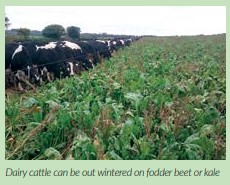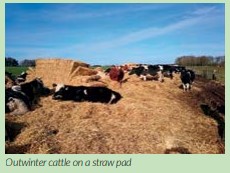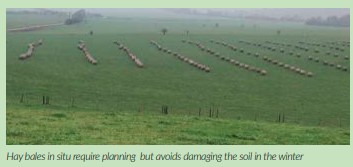Written by William Waterfield FBIAC NFSc. from the Farm Consultancy Group

Are grazing livestock a perquisite of regenerative farming systems? Whilst this is a common thought and perhaps the holy grail for some regenerative farmers, there is little evidence to support this claim. Livestock certainly bring an extra dimension to the diversity of the system and an additional bacterial flora to the soil biota. Many arable farms have no experience of, or facilities for livestock, so do you really need to and if so why and how do you introduce livestock to your arable enterprises?
The why is perhaps the easier of the three questions to answer. Livestock introduce completely different fresh biota to the soils which may be good to the below ground eco system. Livestock, especially larger ones or those that dig are disrupters of the soil by either causing localised trampling or digging whose action creates space for new organisms to thrive. More importantly the stock enterprise should bring with it an income stream that is completely divorced from the vagaries of arable farming. By introducing grass, a new season long crop into the rotation will have benefits for the existing arable enterprise. This maybe from more first cereal or reduced costs in terms of weed and disease control and perhaps a reduction in fertiliser costs.

Assuming that one can obtained composts / bio solids, manures or slurries these may go some way to introducing new biology to the system but are probably not as effective as fresh manure. Having said that, there is some work to show that remial woodchip (uncomposted fine woodchip) improves soil health and yield. The one area that is very difficult to imitate is the effect of trampling on both the above ground material and on the soil surface below. Trampling has the effect of bring plant material into contact with the ground and accelerating the decomposition of material into new plant food.
Having decided that your system will benefit from livestock and that they will contribute to the business both directly and in the round which enterprise do you start with? Suitable livestock enterprises range from simple fattening of store lambs on cover and catch crops to a complete breeding beef cow enterprise based on complex multiyear diverse swards selling finished cattle. Selecting the correct enterprise will depend on several factors including where the farm and farmer is on the regenerative journey, the scale of and the available facilities on the farm the skills available to the farmer either from within the business or by a partner organisation.
The introduction of short term catch crops is often the first step on the regenerative journey and grazing these mixtures with fattening lambs or over wintering ewes would seem to make logical starting point. If a suitable grazier can be found, with a rent charged on a headage basis this is a fairly low risk entry point for many arable farmers.

The introduction of yearlong grass leys does not necessarily mean that a full-time livestock enterprise is required summer grazing licences may be available offering the grazier the opportunity of some fresh and clean grazing with reduction in the need for anthelmintics and lower cost. Alternatively, short term leys of one or two years may simply be cut and made into haulage or hay and sold. For that arable farmer, the key point will most probably be that the ley has to improve soil structure and contribute to the fight against grass weeds.
A season long fodder crop such as fodder beet or kale may be a suitable providing a livestock farmer with a large amount of forage for a short period and this might be fattening cattle or dry stock. Including a legume-based leys may form part of a Countryside Stewardship Schemes where the payments for AB15, a two year sown legume fallow are £522 / ha but needs to be in place for two years and has cutting requirements. Other stewardship options that might be of assistance to regenerative farmers include GS3: Ryegrass seed-set as winter food for birds which pays £331 / ha, this will provide hay or silage and might enable some grazing opportunities. SW6: Winter cover crops which £115 / ha but is only available on soils identified as at risk of runoff in the Farm Environmental Plan.

It is important that the grazier, if one is being used, understands what the arable farmer is trying to achieve. It is no good if the sheep on winter keep delays spring crop establishment or the leys are over stocked and persistently grazed to the floor, resulting in none of the desired trampling of grass being achieved. For these reasons it is often best if the rent is based on a headage rate and the number of stock and the period is agreed before the season starts. A common concern for many arable farmers is the lack of infrastructure and winter accommodation and on very heavy ground or exceptionally wet sites out wintering is probably not a starter. Out-wintering of cattle on straw pads can be an option for some. A more permanent low cost solution is to install a permanent bark pad or corral.
Many graziers are utilising techniques to enable out wintering of cattle for a much longer period than previously. This nearly always combines regular (daily) moves to fresh ground. Grazing of standing hay, the use of baled haulage left in the field from the summer and in a few cases a straw lie back pads and shelter belts. In most cases temporary electric fencing is sufficient to keep the stock in the correct place, especially where plenty of grass is available. Hay bales in situ require planning but avoids damaging the soil in the winter. The provision of water is one key consideration, but mobile drinkers and above ground systems can normally provide a low cost solution to the problem.
The idea that regenerative farming requires a mob grazed herd of cattle kept on diverse and herbal swards is perhaps the idealistic and aspirational end point for some farmers. In which case there is a whole new range of things to be considered. Including breed and breeding, markets, workload and additional skills, combining with potentially more infrastructure. However, such a system might open up premium markets such pasture fed, native breeds or local outlets and then become a diversified enterprise in its own right bring a new profit stream as well as more resilient arable enterprises.